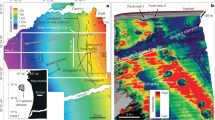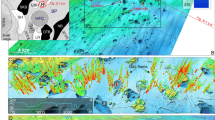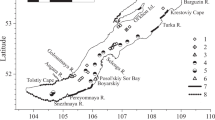Abstract
Below water depths of about 300 metres, pressure and temperature conditions cause methane to form ice-like crystals of methane hydrate1. Marine deposits of methane hydrate are estimated to be large, amassing about 10,000 gigatonnes of carbon2, and are thought to be important to global change3,4 and seafloor stability5,6, as well as representing a potentially exploitable energy resource7. The extent of these deposits can usually be inferred from seismic imaging, in which the base of the methane hydrate stability zone is frequently identifiable as a smooth reflector that runs parallel to the sea floor. Here, using high-resolution seismic sections of seafloor sediments in the Cascadia margin off the coast of Vancouver Island, Canada, we observe lateral variations in the base of the hydrate stability zone, including gas-rich vertical intrusions into the hydrate stability zone. We suggest that these vertical intrusions are associated with upward flow of warmer fluids. Therefore, where seafloor fluid expulsion and methane hydrate deposits coincide, the base of the hydrate stability zone might exhibit significant roughness and increased surface area. Increased area implies that significantly more methane hydrate lies close to being unstable and hence closer to dissociation in the event of a lowering of pressure due to sea-level fall.
This is a preview of subscription content, access via your institution
Access options
Subscribe to this journal
Receive 51 print issues and online access
$199.00 per year
only $3.90 per issue
Buy this article
- Purchase on Springer Link
- Instant access to full article PDF
Prices may be subject to local taxes which are calculated during checkout




Similar content being viewed by others
References
Paull, C. K. & Dillon, W. P. (eds) Natural Gas Hydrates: Occurrence, Distribution, and Dynamics (AGU Monograph no. 124, American Geophysical Union, Washington DC, 2001)
Kvenvolden, K. A. & Lorenson, T. D. in Natural Gas Hydrates: Occurrence, Distribution, and Dynamics (eds Paull, C. K. & Dillon, W. P.) 3–18 (AGU Monograph no. 124, American Geophysical Union, Washington DC, 2001)
Paull, C. K., Ussler, W. & Dillon, W. P. Is the extent of glaciation limited by marine gas-hydrates? Geophys. Res. Lett. 18, 432–434 (1991)
Dickens, G. R., Castillo, M. M. & Walker, J. C. G. A blast of gas in the latest Paleocene: simulating first-order effects of massive dissociation of oceanic methane hydrate. Geology 25, 259–262 (1997)
Paull, C. K., Buelow, W., Ussler, W. & Borowski, W. S. Increased continental-margin slumping frequency during sea-level lowstands above gas hydrate-bearing sediments. Geology 24, 143–146 (1996)
Booth, J. S., Winters, W. J. & Dillon, W. P. Circumstantial evidence of gas hydrate and slope failure associations on US Atlantic continental margin. Ann. N.Y. Acad. Sci. 75, 487–489 (1994)
Collett, T. S. & Kuuskraa, V. A. Hydrates contain vast store of world gas resources. Oil Gas J. 11 May, 90–95 (1998)
Gettrust, J. F., Ross, J. H. & Rowe, M. M. Development of a low frequency, deep-tow geoacoustics system. Sea Technol. 32, 23–32 (1991)
Wood, W. T. & Gettrust, J. F. in Natural Gas Hydrates: Occurrence, Distribution, and Dynamics (eds Paull, C. K. & Dillon, W. P.) 165–178 (AGU Monograph no. 124, American Geophysical Union, Washington DC, 2001)
Westbrook, G. K., Carson, B., Musgrave, R. J. & Suess, E. Proc. ODP Init. Rep. 146 (1994)
Hyndman, R. D. & Spence, G. D. A seismic study of methane hydrate marine bottom-simulating reflectors. J. Geophys. Res. 97, 6683–6698 (1992)
Chapman, N. R. et al. High-resolution, deep-towed, multichannel seismic survey of deep-sea gas hydrates off western Canada. Geophysics 67, 1038–1047 (2002)
Xu, W. & Ruppel, C. Predicting the occurrence, distribution, and evolution of methane gas hydrate in porous marine sediments. J. Geophys. Res. 104, 5081–5095 (1999)
Heggland, R., Meldahl, P., de Groot, P. & Aminzadeh, F. Chimney cube unravels subsurface. Am. Oil Gas Reporter 78–83 (February 2000)
Meldahl, P., Heggland, R., Bril, B. & de Groot, P. Identifying faults and gas chimneys using multiattributes and neural networks. Leading Edge 20, 474–482 (2001)
Hovland, M. & Judd, G. Seabed Pockmarks and Seepages 181 (Graham & Trotman, London, 1988)
Voss, C. I. A finite element simulation model for saturated and unsaturated, fluid-density-dependent ground-water flow with energy transport or chemically reactive single species solute transport (USGS Water Resources Investigations Report 84–4369, 1984).
Brown, K. M., Bangs, N. L., Froelich, P. N. & Kvenvolden, K. A. The nature, distribution and origin of gas hydrate in the Chile Triple Junction region. Earth Planet. Sci. Lett. 139, 471–483 (1996)
Fisher, C. R. et al. Methane ice worms: Hesiocaeca methanicola colonizing fossil fuel reserves. Naturwissenschaften 87, 184–187 (2000)
Paull, C. K., Matsumoto, R. & Wallace, P. Proc. ODP Init. Rep. 164 (1996)
Korenaga, J., Holbrook, W. S., Singh, S. C. & Minshull, T. A. Natural gas hydrates on the southeast U.S. margin: Constraints from full waveform and travel time inversions of wide angle seismic data. J. Geophys. Res. 102, 15345–15365 (1997)
Acknowledgements
We thank C. Voss for advice on finite element modelling.
Author information
Authors and Affiliations
Corresponding author
Ethics declarations
Competing interests
The authors declare that they have no competing financial interests.
Rights and permissions
About this article
Cite this article
Wood, W., Gettrust, J., Chapman, N. et al. Decreased stability of methane hydrates in marine sediments owing to phase-boundary roughness. Nature 420, 656–660 (2002). https://doi.org/10.1038/nature01263
Received:
Accepted:
Issue Date:
DOI: https://doi.org/10.1038/nature01263
This article is cited by
-
Gravity complexes as a focus of seafloor fluid seepage: the Rio Grande Cone, SE Brazil
Scientific Reports (2023)
-
Submarine slope failures due to pipe structure formation
Nature Communications (2018)
-
Mechanical instability of monocrystalline and polycrystalline methane hydrates
Nature Communications (2015)
-
Pockmarks on either side of the Strait of Gibraltar: formation from overpressured shallow contourite gas reservoirs and internal wave action during the last glacial sea-level lowstand?
Geo-Marine Letters (2014)
Comments
By submitting a comment you agree to abide by our Terms and Community Guidelines. If you find something abusive or that does not comply with our terms or guidelines please flag it as inappropriate.



